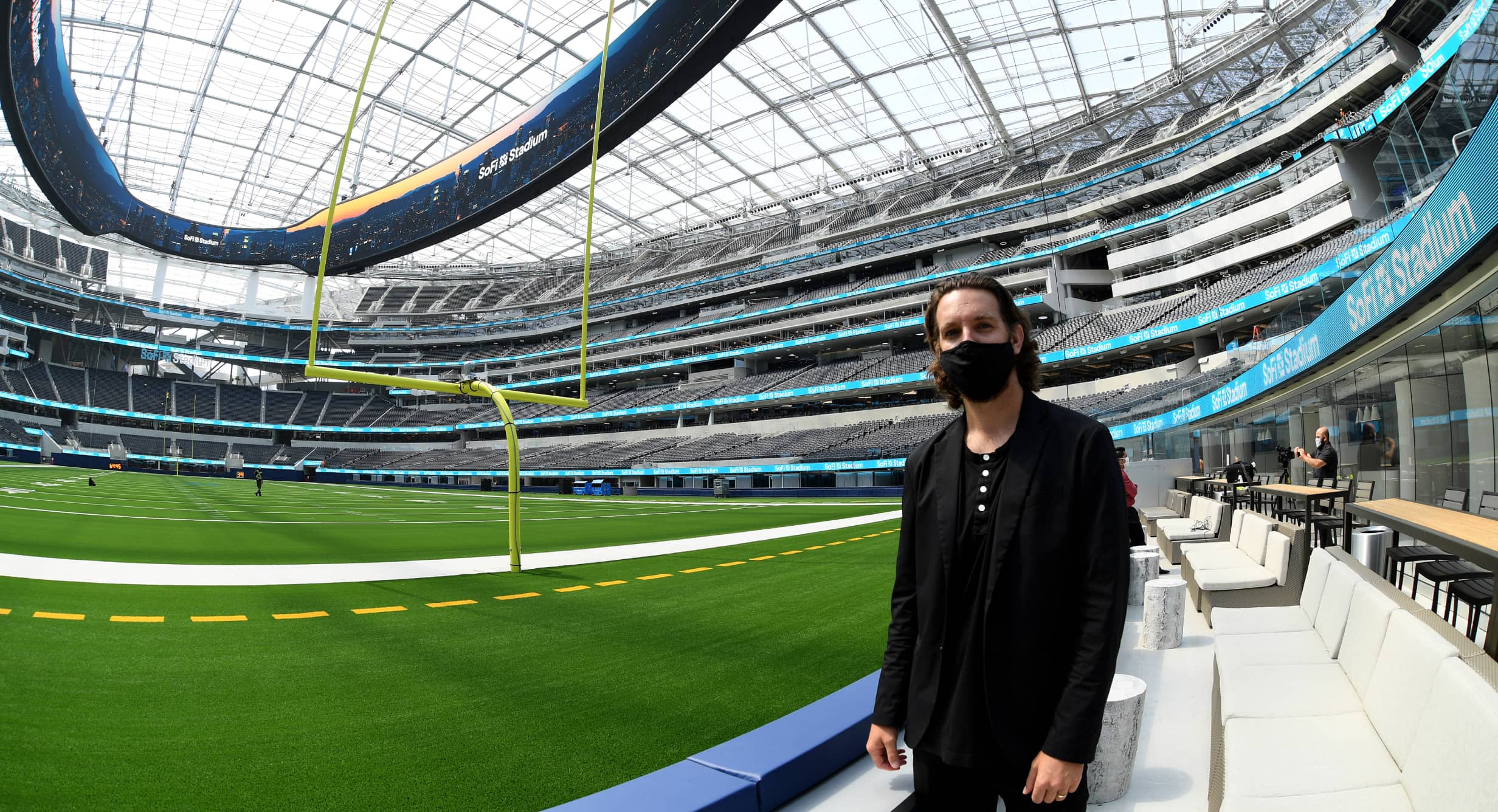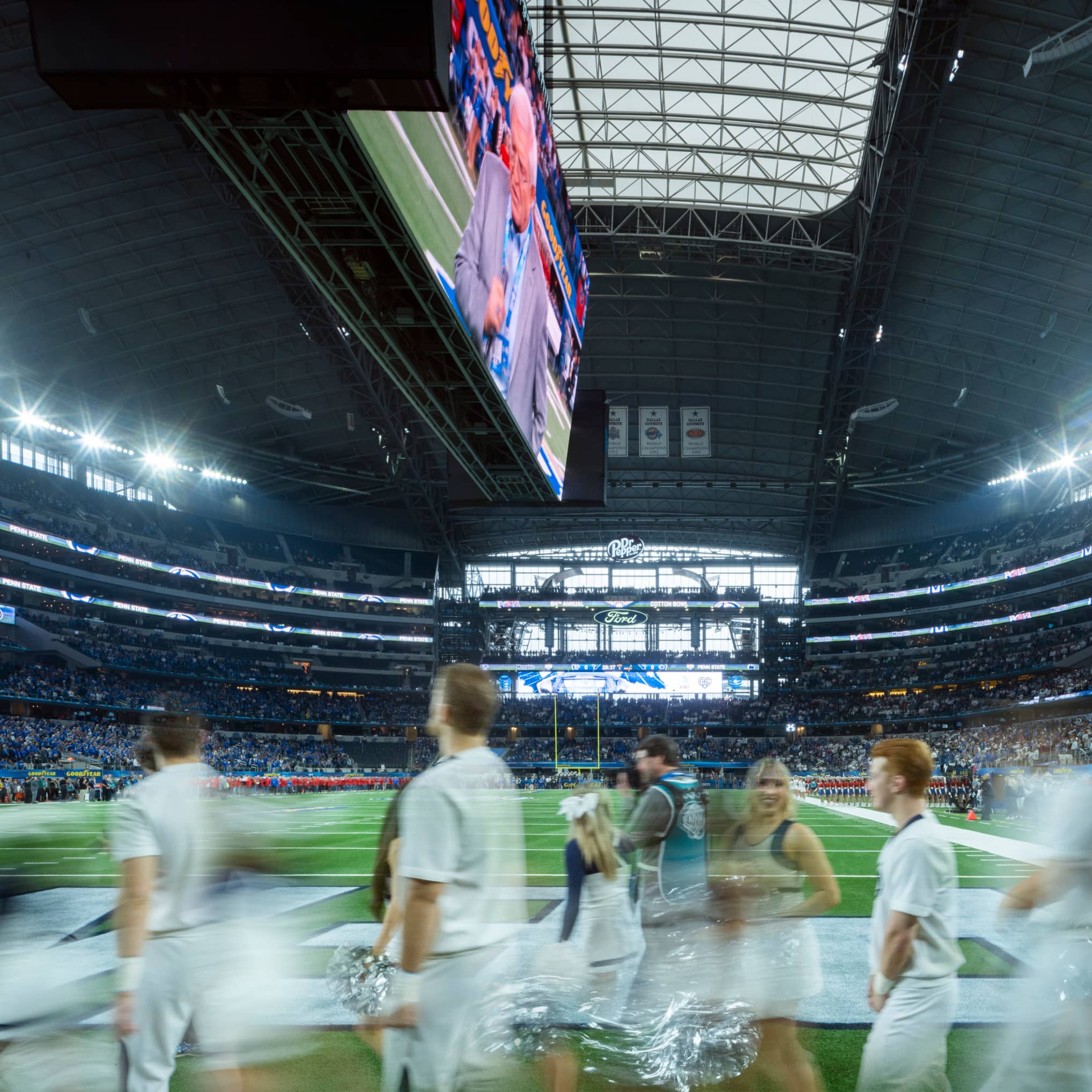
HKS’ Lance Evans Inspires Sports Heroes with Dazzling Venues
Designing dazzling sports venues wasn’t on the mind of Lance Evans when he began his architecture career at HKS in 2004. Then he was just hoping to refine his residential design skills in a fast-paced and diverse city.
Fate soon nudged him in a different direction.
Just months into Evans’ new job at the HKS Los Angeles office, the firm landed the opportunity to design a new stadium for the Dallas Cowboys. Evans, a Texas native and die-hard Dallas Cowboys fan, begged for a spot on the design team. When he finally got his wish, he worked many late nights to balance the stadium’s work with his other HKS projects.
“It was just by chance that the firm I had decided to work at . . . was going to design the future stadium of the Dallas Cowboys,” Evans said. “And that’s where the whole trajectory of my life changed.”
Evans doesn’t need to beg to be a part of big sports projects anymore. As a Principal and Venues Design Director at HKS, he’s often asked to help lead the design of them.
His biggest project yet is Southern California’s SoFi Stadium, the National Football League’s largest and home of the Los Angeles Rams, Chargers and Super Bowl LVI. It’s also just a mile from Evans’ Westchester, California home, a rare opportunity for the sports designer — who was the lead architect on the massive project — to work on a major venue practically in his own backyard.
Turning Sports Dreams into Design Dreams
Though Evans has spent most of his adult life in California, his roots trace back to Texas. He grew up in San Antonio, both playing and watching sports. He would often gather in the backyard with his friends to recreate the greatest plays of their childhood idols: Troy Aikman, Emmitt Smith and Michael Irvin of their beloved Dallas Cowboys.
He played baseball and basketball in high school, but his dreams of athletic glory were dashed when a coach told him that a professional sports career was out of his league and advised him to develop more realistic career options.
He later decided to study architecture at Texas Tech University, a decision that didn’t surprise his family. On their vacations to Galveston Island, a young Evans didn’t really care to play in the ocean. He preferred to marvel at the island’s historic homes and sketch his own houses as an early foray into the built environment.
After college, Evans was ready to continue learning how to properly put together a building. A college professor said HKS was good at that, so Evans joined the Los Angeles office of the Dallas-based firm to focus on picking up new skills that would help him design homes eventually.
But when the AT&T Stadium project came around, Evan’ career trajectory became clear : What could be more special than designing sports venues to inspire athletes who have inspired him all his life?
“What I really took from that experience was this idea was that we were trying to invent something,” Evans said. “Through the process of invention – trial and error, research-based design, connecting with team’s culture and community – we were trying to build something that’s both unique and familiar to the team and its fans. That is what enticed me to stay at HKS and pursue sports as a career path.”
This mindset of invention and innovation led to many milestones for Evans and his colleagues.
At AT&T Stadium, the design team revolutionized the fan experience with a massive Mitsubishi screen that at the time was the largest LED videoboard in the world. Nearly 1,000 miles to the north, the Minnesota Vikings’ U.S. Bank Stadium built on the successes of AT&T Stadium for an unrivaled, yet localized, fan experience. That HKS-designed stadium has its own large LED videoboards, and America’s first ETFE stadium roof to give fans and players the feeling of being outdoors without having to be directly exposed to the area’s brutal climate.
The AT&T Stadium and U.S. Bank Stadium projects, along with Lucas Oil Stadium in Indianapolis, eventually teed up Evans and his HKS colleagues for their next big NFL project – SoFi Stadium — and when that opportunity came around, it only made sense to, once again, do something that had never been done before.

Inspiring His Sports Heroes
Evans had worked his way up to becoming a leader within the HKS Sports practice when Mark Williams, now the Global Director of Venues at HKS, called him one day in 2014 and asked what he thought of HKS vying for the Los Angeles Rams’ new stadium in Inglewood. Evans was instantly fired up about the project.
“Designing sports facilities around the globe, not often do you get to design one in your backyard,” Evans said. “I live a mile or so from SoFi (Stadium), so this opportunity was jumping off of the page. I was screaming for the chance to be involved in this project from its early days.”
Rams Owner/Chairman E. Stanley Kroenke wanted the new stadium to accomplish two main tasks: create an entertainment destination in the entertainment capital of the world and feature architecture embodying the spirit of southern California.
“Our design team took this to heart, and it led every decision on this building,” Evans said. “This was a chance to build an entertainment destination in the entertainment capital of the world. It was about authenticity and how you can capture the essence of a community in the ultimate fan experience.”
The result: a 298-acre sports and entertainment destination at Inglewood’s Hollywood Park that capitalizes on the Los Angeles area’s highly coveted climate and relaxed lifestyle, while also taking seismic challenges into consideration. As the project’s centerpiece, SoFi Stadium treats visitors to natural light, Pacific Ocean breezes, and landscaping inspired by Southern California’s topography as the NFL’s first indoor-outdoor stadium.

“The idea of authenticity really drives our architectural expressions, and that’s why the stadiums we designed for Indianapolis, Dallas, Minnesota, and now Los Angeles, all have a unique identity,” Evans said. “They are all representative of the place in which we built them and designed them, and the communities and teams that we designed them for.”
Chris Meany, who was part of Hollywood Park’s development team, said he was impressed with Evans’ work ethic from the start of the design process because of his ability to collaborate with a large team to balance multiple structures under tight schedules. And Evans managed to do this while maintaining his reputation as an “affable guy” with a passion for architecture, Meany said.
Evans and the HKS team took time early in the process to dig into the concept of “embedded places,” spaces that are quintessentially part of Los Angeles, to fuel the design process and inspiration for Hollywood Park’s new stadium. That approach, Meany said, resonated with the development team and the Rams.
“The process needs passion, and it needs the pressure of multiple people arguing with you. You need to have real debate, out of which emerge better ideas,” Meany said. “What Lance brings to the table is, and in a nice way because he’s a nice guy, a willingness to fight for what he believes is important in the design and out of that comes a better building.”
But SoFi’s unveiling was different than those of other Evans’ projects. Because of COVID-19, the Rams and Chargers experienced their first games in the stunning stadium without fans.
Watching the team walk into an empty stadium did, however, allow the design team a rare look at their clients’ reactions to their new home. Evans describes it as a surreal experience, viewing the players’ walk on to the field with a sense of awe and wonder at the sight of palm trees, the translucent roof, and a massive Infinity Screen.
“Seeing your heroes be inspired is so rewarding,” Evans said. “When the players you look up to get inspired by something you contributed to, that’s the most rewarding thing.”
But Evans hasn’t just limited his observations of reactions to the stadiums to players. Since SoFi Stadium opened, he often tries to snag a window seat whenever he takes nighttime flights into or out of Los Angeles International Airport. That way, he can catch a birds-eye view of the glimmering stadium and the LED screen on top of it that makes the roof a giant TV screen.
Seeing fellow passengers react to whatever is playing on the screen – a playoff game, a Hollywood movie promo, celebratory messages related to Southern California – always brings Evans a touch of joy.
“The screen has become this great postcard to Los Angeles, where memorable things happen,” Evans said. “It’s become this wonderful message board for the community – something I wasn’t expecting.”
And Evans also may not have expected the stadium to gain as much attention as it has, even before the Super Bowl. Nearly a year and a half after the stadium opened, the Rams stood on the field to celebrate winning the 2022 NFC Championship title after a thrilling game against the San Francisco 49ers.
“Whose house?” Kroenke, the Rams owner, shouted into the microphone as he accepted the NFC Championship trophy.
“Rams house!”, players and fans bellowed back, as blue and yellow confetti reigned throughout the energy-filled stadium.




